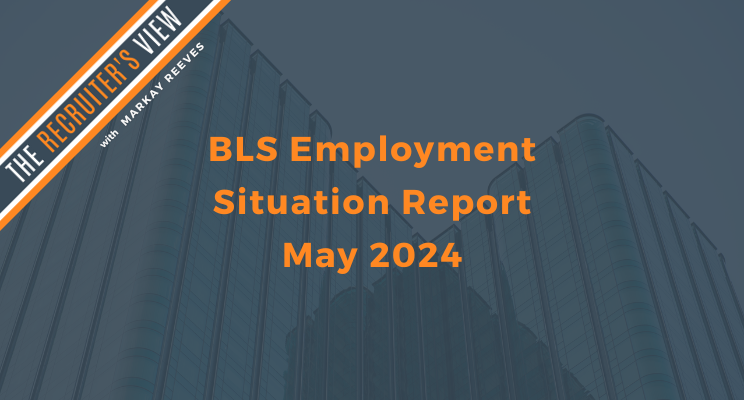
Most labor market watchers from Wall Street to Main Street and in Washington DC were expecting to see a modest uptick in job growth in today’s data released by the Bureau of Labor Statistics monthly payroll report (BLS).
The 272,000 job gain was a bit more than the experts’ “modest” expectations, indicating a still growing economy and reducing the likelihood of a short-term cut in interest rates by the Fed. May’s growth was higher than the average gain of 232,000 over the past twelve months and saw gains in a broader range of industries verses the past few months.
The unemployment rate ticked up to 4.0 percent. A year earlier the rate was 3.7 percent.
“An underlying driver of not only today’s job market data but of the overall economy has been the anticipated impact of artificial intelligence on business productivity in virtually every industry. Our talent sourcing industry is no exception and in fact today we see benefits from AI not only in technology jobs but in talent search assignments ranging from healthcare and medical devices to engineering, finance and cyber security firms.
In May, forty of our franchise owners gathered to share best practices and to gain insight on technology trends from leading industry suppliers. A key topic from the Charleston, SC meeting was to better understand how AI, and its application on digital technology platforms, can enhance talent delivery effectiveness for search professionals and for clients and candidates,” noted Rick Hermanns, president and chief executive officer of HireQuest Inc., parent company of MRINetwork.
“Our professionals recognized that AI is significantly impacting search and recruitment processes right now. Many owners and managers throughout the global MRINetwork are using AI-driven tools to streamline various stages of the hiring process; from sourcing candidates, to resume screening, to analyzing initial assessments. We are finding not only obvious advantages including improved search efficiency and faster speed to hire but are seeing exciting potential in evaluating job requirements and more accurately aligning candidate skills, experience, and cultural fit to that job description.”
Providing an overview of today’s surprising uptick in the BLS data, The Wall Street Journal’s Sam Goldfarb noted, “Friday’s release comes after several recent reports have hinted at some unexpected weakness in the economy. Recent data on retail sales, overall consumer spending, construction and industrial production have all come in below economists’ expectations. Demand for workers has also appeared to be ebbing. There has been a modest uptick in the number of people applying for unemployment benefits after losing a job. Listed job openings have declined faster than economists had anticipated.” He further noted, “Most economists have remained optimistic about the near-term outlook, believing the economy is normalizing after a surprisingly hot stretch last year, rather than deteriorating in a more concerning fashion. Any anxieties on Wall Street that the economy might be cooling too fast were also mitigated earlier this week with the release of a stronger-than-expected report on the U.S. services sector.”
A possible explanation of the divergence between big increases in the payroll while also seeing a growth in unemployment, Ali Jaffery at CIBC Capital Markets noted, “We have tended to favor payrolls data given it better captures the impact of immigration.”
Employment continued to advance in several industries.
Healthcare added 68,000 jobs in May, in line with the average monthly gain of 64,000 over the prior 12 months.
Government employment continued to grow in May (+43,000), in line with the average monthly growth over the prior 12 months (+52,000).
Employment in leisure and hospitality continued to trend up in May (+42,000), similar to the average monthly gain over the prior 12 months (+35,000). Employment in food services and drinking places continued to trend up over the month (+25,000).
Professional, scientific, and technical services added 32,000 jobs in May, higher than the average monthly gain of 19,000 over the prior 12 months. Over the month, employment increased in management, scientific, and technical consulting services (+14,000) and in architectural, engineering, and related services (+10,000).
In May, employment in retail trade continued to trend up (+13,000), about in line with the average monthly gain over the prior 12 months (+8,000). Building material and garden equipment and supplies dealers provided most of that growth (+12,000).
Employment showed little or no change over the month in other major industries, including mining, quarrying, and oil and gas extraction; construction; manufacturing; wholesale trade; transportation and warehousing; information; financial activities; and other services. The transportation sector had added 22,000 jobs in April possibly indicating a slowdown in growth in that key industry.
“AI has already had a significant influence on many industries, and we’ve seen a significant impact within the healthcare segment which was the leading sector in today’s BLS data. The new technology promises improvements to mundane tasks such as taking notes and adding data to electronic health records without intense oversight from busy healthcare professionals. But it has only begun to show its value in collecting and analyzing data from diverse technologies and sources to provide a holistic view of a patient’s health and even treatment options.
MRINetwork talent professionals in our healthcare practices are helping both clients and candidates to understand how this wave of AI innovation will change every facet of healthcare recruitment. We advise candidates to embrace computer literacy to stand out as top performers and we work with clients to apply AI solutions to their workforce planning, recruitment and hiring processes. We look forward to the exciting evolution changing the healthcare talent landscape,” noted Hermanns.
To view the entire Employment Situation report from the U.S. Bureau of Labor Statistics, click here.
Article provided by MRI Network.